Rapid Rehousing: A Long-Term Solution?
Homelessness, however, presents complex challenges. Solutions, furthermore, often aim for immediate relief. They, additionally, also strive for lasting stability. Rapid Rehousing has, consequently, emerged as a leading intervention. It, furthermore, promises quick results. It, moreover, helps people move into permanent homes. However, a common question, therefore, arises: “Is Rapid Rehousing a long-term solution?” The answer is, furthermore, nuanced. This blog explores the pros and cons. You will, consequently, understand its strengths. You will, furthermore, also learn its limitations. This will, therefore, clarify its role in addressing homelessness.
Understanding the Philosophy Behind Rapid Rehousing
Rapid Rehousing is a housing-first approach. It, therefore, prioritizes placing individuals directly into permanent housing. It does not, furthermore, require preconditions. For example, sobriety or employment are not mandatory first steps. Instead, support services are, consequently, provided after housing is secured. This philosophy argues that stable housing is fundamental. It, furthermore, provides the necessary foundation. People can then effectively address other life challenges.
The Pros of Rapid Rehousing: Why It’s So Effective
Rapid Rehousing offers several significant advantages. These, consequently, make it a highly effective intervention.
1. Rapid Rehousing Enables Fast Placement into Permanent Housing
The most obvious benefit is speed. Rapid Rehousing quickly moves people. They, furthermore, transition from homelessness to a stable home. This, moreover, minimizes the time spent in shelters. It, additionally, reduces the trauma of street homelessness. It, furthermore, prevents the escalation of related issues. This immediate stability is, therefore, crucial.
2. Cost-Effectiveness
Compared to other interventions, Rapid Rehousing is often more affordable. It, furthermore, reduces reliance on expensive emergency shelters. It, moreover, avoids prolonged stays in transitional housing. Resources are, consequently, used efficiently. This cost-effectiveness allows programs to serve more people. It, furthermore, optimizes public and private funding.
3. Client Choice and Autonomy in Rapid Rehousing
Clients, furthermore, have a say in their housing. They, moreover, choose their own rental units. This, consequently, promotes autonomy. It, furthermore, fosters a sense of ownership. This control over their living situation is, therefore, empowering. It, moreover, contrasts with more restrictive program settings.
4. Focus on Individualized Support in Rapid Rehousing
Support services are, furthermore, tailored. Case managers, moreover, assess specific needs. They, consequently, connect clients to relevant resources. This flexible approach, therefore, ensures targeted help. It, furthermore, respects individual circumstances. It, moreover, avoids a “one-size-fits-all” model.
5. Rapid Rehousing Reduces Trauma and Stress
Homelessness is, furthermore, inherently traumatizing. It, moreover, causes immense stress. Rapid Rehousing quickly removes this burden. It, furthermore, provides a safe, private space. This, consequently, allows individuals to begin healing. It, furthermore, reduces the psychological toll of instability.
6. High Housing Retention Rates in Rapid Rehousing
Studies, consistently, show high success rates. A large majority of Rapid Rehousing participants remain housed. This long-term housing stability is, consequently, a key indicator. It, furthermore, proves the model’s effectiveness.
Potential Limitations
Despite its many advantages, Rapid Rehousing does have limitations. These, furthermore, need careful consideration.
1. Rapid Rehousing and Time-Limited Financial Assistance
The rental assistance is temporary. This is, furthermore, a core component. However, some clients may, consequently, struggle. They might not, furthermore, achieve full financial self-sufficiency. This can, therefore, lead to renewed housing instability. It, moreover, requires a solid exit strategy.
2. Support Intensity Can Vary in housing programs
Support services are, furthermore, individualized. For some, the intensity might be insufficient. Individuals with complex needs may, furthermore, require more. They might need longer-term, specialized care. This could, for example, include severe mental health issues. It might, alternatively, involve chronic substance abuse.
3. Rapid Rehousing Faces Challenges in the Housing Market
Finding affordable housing can be difficult. A tight rental market, consequently, presents hurdles. Landlords might, furthermore, be reluctant to rent. They could, moreover, be wary of a history of homelessness. This can, therefore, delay placements. It can, furthermore, stress program resources.
4. Client Engagement is Crucial for Rapid Rehousing Success
Clients must, furthermore, be willing to engage. They need to, moreover, participate in services. They must, additionally, work towards their goals. Some individuals might, consequently, struggle with motivation. They might, furthermore, face other personal barriers. This could, therefore, impact their success.
5. Rapid Rehousing Is Not a Cure-All
Rapid Rehousing excels at providing housing. However, it is not, furthermore, designed to “cure” underlying problems. It, moreover, provides a stable base. But deeper, ongoing support is, however, often needed. It, furthermore, relies on connections to external resources.
When Is Rapid Rehousing a Long-Term Solution?
Rapid Rehousing functions as a long-term solution when certain conditions are met.
Strong Linkages to Ongoing Support Post-Rapid Rehousing
Success, therefore, depends on robust connections. Clients need ongoing mental health care. They need, moreover, substance abuse treatment. They, additionally, require employment services. These must, furthermore, extend beyond the program’s timeframe. Seamless transitions are, consequently, crucial.
Client’s Ability to Gain Income After Rapid Rehousing
Clients must, furthermore, gain sufficient income. They need to, moreover, pay rent independently. This, consequently, requires job readiness. It, furthermore, also requires financial literacy. The program empowers this, but client effort is, consequently, key.
Stable Housing Market
An accessible housing market, moreover, helps. It, therefore, provides affordable rental units. This, consequently, reduces barriers to placement. It, furthermore, allows for more choices. It, additionally, ensures successful transitions.
When Might Other Approaches Be Better?
For some individuals, Rapid Rehousing might not be the initial best fit.
Chronic and Severe Needs Beyond Rapid Rehousing
Individuals with chronic, severe mental illness may, furthermore, need more. They might, moreover, require longer-term, supportive housing. This, consequently, offers intensive, integrated services. Permanent Supportive Housing (PSH) is, furthermore, an example.
Rapid Rehousing vs. Structured Substance Use Treatment
Some individuals, moreover, need immediate, structured treatment. They might, therefore, benefit from residential programs first. Rapid Rehousing works best once initial stabilization occurs.
Severe Barriers May Require Alternatives to Rapid Rehousing
People with multiple, severe barriers may, furthermore, need more time. They might, therefore, benefit from transitional housing. This, consequently, provides a longer, more intensive period of skill-building.
The Role of Follow-Up and Aftercare
Even after exiting Rapid Rehousing, continued support is beneficial.
Post-Program Case Management
Some programs, furthermore, offer brief follow-up. This, consequently, helps address emerging issues. It, furthermore, provides continued connection to resources. It, additionally, ensures sustained stability.
Community Integration
Clients should, moreover, be fully integrated into the community. They should, furthermore, connect with social supports. They should, additionally, access ongoing services. This, consequently, helps prevent future crises.
Conclusion
Is Rapid Rehousing a long-term solution? Yes, for many, it absolutely is. furthermore it, provides a highly effective pathway. It, consequently, moves people from homelessness to stable housing. It, moreover, offers vital, individualized support. Its benefits are clear: speed, cost-effectiveness, and high retention. However, it is not a universal panacea. For some, it might be the starting point. They might, moreover, need additional, long-term support. A comprehensive system, furthermore, includes diverse interventions. It, consequently, tailors solutions to individual needs. Rapid Rehousing is a powerful, essential piece of the puzzle. It, furthermore, significantly contributes to ending homelessness. It, moreover, helps countless individuals build stable, lasting futures.
National Hot Line for Homelessness





